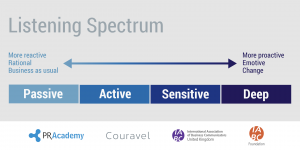Who’s listening?
We’ve found not surprisingly, that COVID-19 has sped up the rate at which organisations are adopting new, online ways of listening to employees and believe that listening will continue to grow in importance to connect people to organisations.
We have also set out how organisations can assess their maturity against a spectrum of approaches.
Sometimes senior managers say they want to listen but do not want to believe or accept what they hear or are genuinely unsure what to do about what they hear
What has worked well in listening: “Using a range of methods (small and large group discussions, many channels, chance for anonymity)”
Who's Listening? Report Part 1
Download the report to understand:
- What constitutes good listening
- Different styles of listening
- What gets in the way of good listening practice
- What the future of listening looks like
- How communication managers can lead the way

We respect your privacy and handle your data with care. Please see our privacy policy.
Thank you for downloading this report. Your download should start immediately.
If you asked us to keep you up to date with new guides and the latest industry insights, you will receive an email shortly asking you to verify the address we need to send them to.
Who's Listening? Report 2020 Update
In the report you will discover:
- Case studies of good listening from around the world
- Practical tools for listening in your organisation
- How leaders and communicators can listen effectively

We respect your privacy and handle your data with care. Please see our privacy policy.
Thank you for downloading this report. Your download should start immediately.
If you asked us to keep you up to date with new guides and the latest industry insights, you will receive an email shortly asking you to verify the address we need to send them to.


